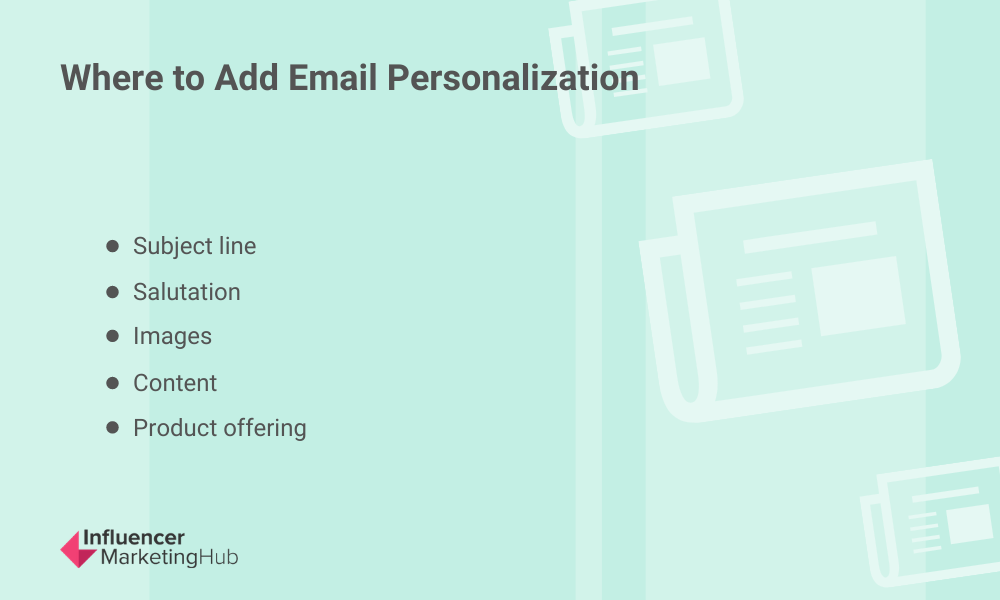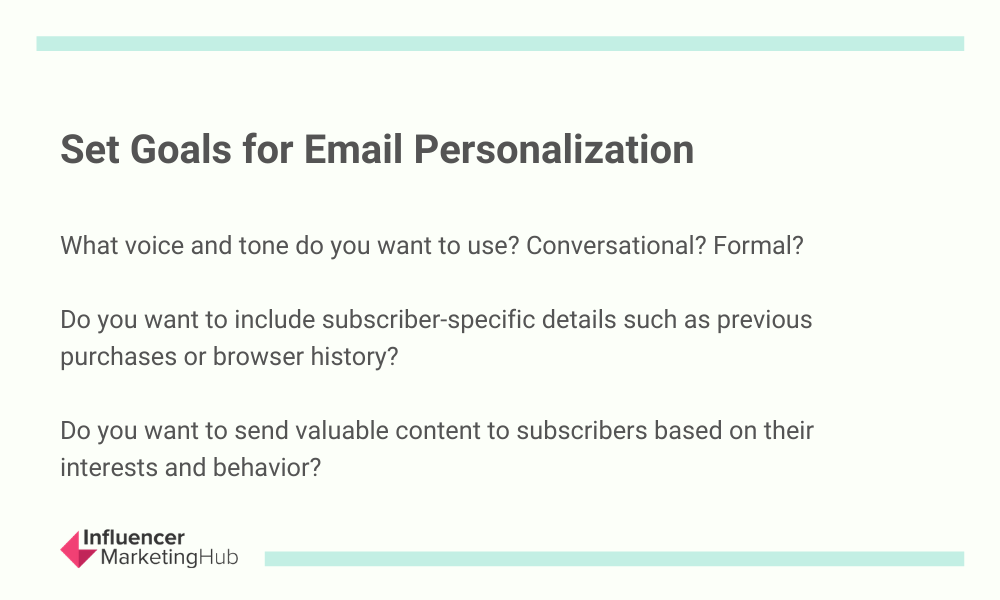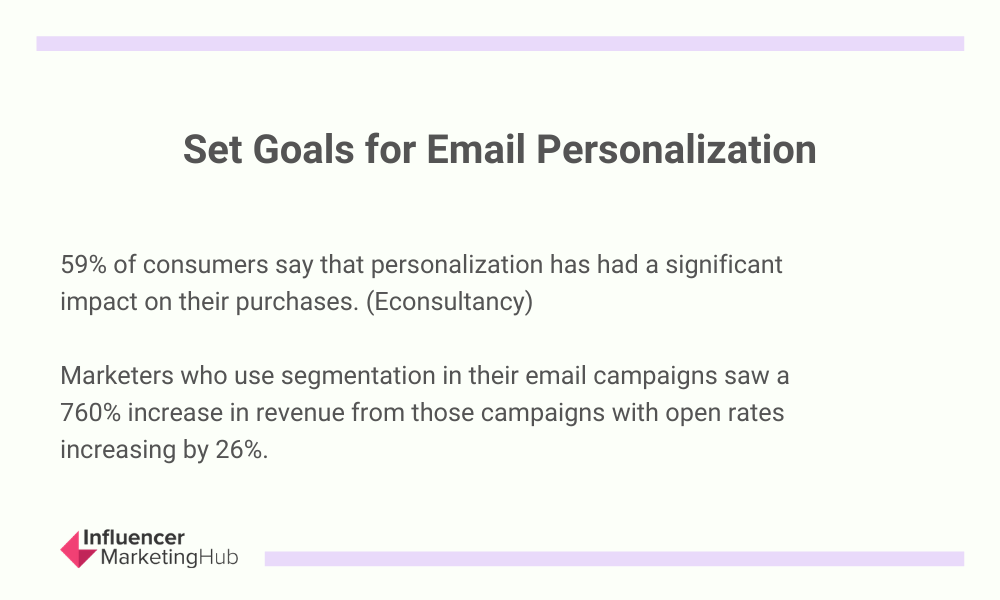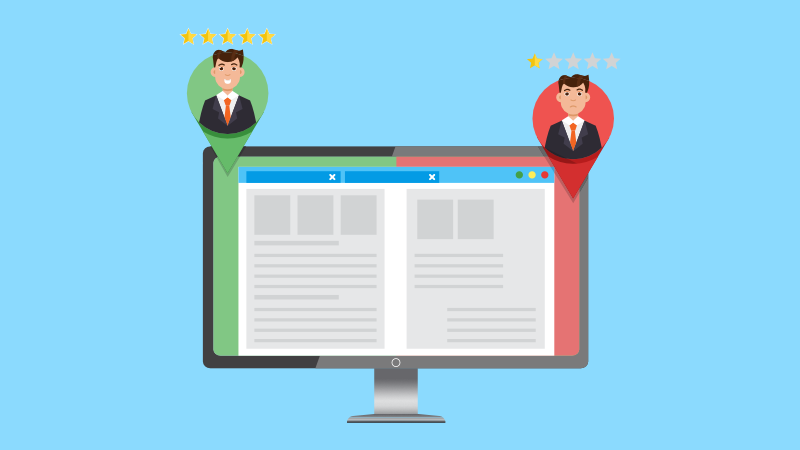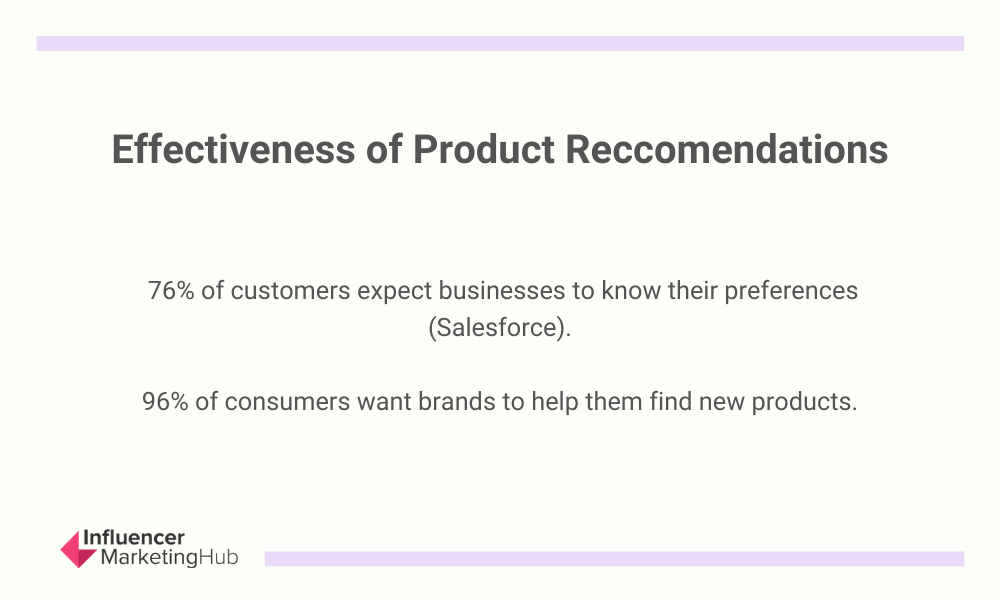Email personalization can help you better connect with your target audience than a generic, one-size-fits-all message or offer. When your subscribers receive emails using their name, location, information about previous purchases, or other personalized information, it makes them feel as though you’re writing just to them and makes them more open to what you have to say. Nearly all businesses (94.2%) personalize their email marketing campaigns (Monetate, 2019).
Email personalization works because personalized emails are more relevant to those receiving them. You can use personalization to target very specific segments of your audience, providing offers, products, and services that match their interests.
But what exactly is email personalization and why does it really matter? In this article, we’ll cover both of those questions as well as 10 email personalization best practices you can use to create targeted, personalized emails that delight your target audience.
If you’re completely new to email marketing, we suggest starting with our guide to email marketing before coming back and diving into personalization.
Email Personalization Best Practices that Get Results:
What Is Email Personalization?
Email personalization is the act of targeting email campaigns to specific subscribers using the data and information you’ve already collected from them. This could be their names, products they’ve purchased, their location, how active they are on your app, or any other of a broad range of data. Here’s an example of a personalized email from Bulb Energy:

Source: reallygoodemails.com
While the example above is complex and includes tons of personalized information, it doesn’t have to be complicated. Simply adding a subscriber’s name to an email subject line is email personalization. As you can see from Bulb Energy’s email, you can also get quite complex with your email personalization by including products or services specific to age, location, or gender identification, or other details you’ve learned about them.
There are several places you can include personalization in your email marketing:
- Subject line
- Salutation
- Images
- Content
- Product offering
Now that you understand what email personalization is, let’s take a look at why it matters and why you should start using personalization in your email marketing campaigns.
Why Email Personalization Matters
According to a study by Litmus, email personalization is the number one trend in email marketing with nearly 40% of email marketers indicating that improving email personalization was their number one email marketing goal. That’s because email personalization is proven to improve email marketing metrics like ROI and engagement rates as well as improving the sender’s reputation and increasing open rates.
As you can see, email personalization offers several benefits. In addition to those we’ve mentioned above, email marketers have reported that a personalized email experience increases sales and improves customer satisfaction. This is largely because people don’t want to be seen and just one in a number of others, they want to be seen as individuals and treated as such.
There have been several studies conducted on email personalization that have found that Millennial brand loyalty increases 28% if they’ve received personalized communication (SmarterHQ). Not only that, but a 2019 report from The Relevancy Group and Liveclicker found that email marketers using advanced personalization techniques see up to a $20 return on every $1 invested in email marketing.
Could you use an ROI like that? If you want to start using personalization to get more from your email marketing, keep reading. In the next section, we’ll cover 10 email personalization best practices that will keep your subscribers—and your bank account—happy.
10 Email Personalization Best Practices
Sending personalized, relevant, targeted emails to your subscribers is a great way to nurture relationships with the people on your email list. The more you can show your subscribers that you understand them and care about what they want, the more loyal they will be to your brand. To get the best results from your email marketing efforts, employ these 10 best practices for email personalization.
1. Create Customer Personas
If you don’t already have them, create customer personas for each of the types of customers you want to bring in. You have to start with a good grasp on who your target audience is before you can hope to use personalization in your email marketing efforts. You’ll want to create at least one persona (most brands have 1–3 personas they target). Really work to build a complete picture of what your personas want and how they behave. This is a great starting point for email personalization.
2. Set Goals
What do you hope to achieve with your email marketing campaigns and how will personalization help you meet those goals? There are tons of ways to personalize emails, as we mentioned earlier. Setting goals for your email marketing will make it a lot easier to choose how you’ll personalize your emails. Here are a few questions to ask yourself when setting goals for personalization in your email marketing campaigns:
- What voice and tone do you want to use? Conversational? Formal?
- Do you want to include subscriber-specific details such as previous purchases or browser history?
- Do you want to send valuable content to subscribers based on their interests and behavior?
3. Collect Data
To succeed with email personalization, you’ll need data. But there is such a thing as too much data, so be sure to set boundaries from the start. You’ll want to choose a small number of data points to start. This will likely be basic demographics like age, gender identity, and location.
Once you’ve gotten a handle on this basic information and how to use it to personalize your email marketing campaigns, you can start looking at psychographic data. This includes data about customer behavior (onsite and offsite) such as how they interact with your website, what they do on social media, if they use coupons, and a lot more.
4. Segment Your Email List
As soon as you start collecting data, you can segment your email list. You can segment your email list based on just about anything, but beware of hyper-segmentation. You’ve already created your personas and each of those personas is a great place to start segmenting. From there, though, it can be easy to get really into the weeds. Instead of segments based on customer behavior and location, you’ll end up with hundreds of segments for things like “people who purchased three purple pocketbooks on the third Monday of July.”
That’s not helpful. Segments should make it easier to create targeted, relevant offers that can be automated.
You’re not going to be able to keep everyone happy all of the time. That doesn’t mean that you segment and segment and segment. Instead, focus on broader commonalities between subscribers. Location is a great place to start because people love knowing what’s going on locally.
Your potential customers are flooded with advertising messages all day, every day. Sending relevant offers based on your target audience’s interests shows that you’re different from the others. You actually care about them and what they want.
And this level of personalization can get you what you want.
Econsultancy found that 59% of consumers say that personalization has had a significant impact on their purchases. And, marketers who use segmentation in their email campaigns saw a 760% increase in revenue from those campaigns with open rates increasing by 26%.
Segmentation works.
5. Leverage Dynamic Content
Dynamic content is content in your emails that changes depending on the segment of your audience receiving the email. This means you can create multiple versions of the same email and customize the email to show a specific element only to a specific segment of your audience. Dynamic content changes based on the preferences, interests, and behavior of the recipient.
How cool is that?
Dynamic content can save you so much time when creating your email marketing campaigns. You only need to create a single email that you then customize based on the segment you’re sending it to. You can set dynamic content to change based on things like gender identity, weather, location, past purchases, loyalty program status, and many, many other data points. Your recipient will feel special because the email they’re getting is filled with relevant information and messaging they’re interested in.
6. Use Personalization Naturally
Just because you have information about a subscriber doesn’t mean you should use it all the time. Email personalization should come across as natural. If it feels forced, your readers will definitely notice. Personalization should make it easier to build a personal connection with your readers. It will also help you create emails faster and easier, but you should only use it when it makes sense.
7. Test Your Emails
Testing your email marketing campaigns is going to make every email you send better. When you’re adding in personalization or email triggers for automated campaigns, testing becomes even more important. Once you’ve created an email campaign using personalization, be sure to send a test message to yourself to make sure that everything is correct.
Don’t just test on computers, either. Nearly half of email users check their email from their smartphones, so you’ll want to make sure your emails look right on mobile devices, too.
8. Use Email Automation
Email automation is a powerful tool that can help you send the right message to the right people at the right time. Most email marketing service providers (ESP) offer some level of automation. If you haven’t already chosen an ESP, make sure that the one you go with has the automation tools you need. You can automate emails based on actions subscribers take on your site, subscriber birthdays, membership renewals, when customers purchase a certain number or value of products, and a lot more.
You can even use automation to update emails each time they’re opened. This is especially useful for triggered emails like shipping notifications. When the user opens the email, the content is automatically updated with the most recent information so they can see their tracking information right there. No need to click off to another website.
9. Include Product Recommendations
A Salesforce study found that 76% of customers expect businesses to know their preferences, and personalized product recommendations will let subscribers know that you understand them. An easy way to add targeted product recommendations to personalize your emails is by offering customized product recommendations or information based on customers’ past purchases.
You don’t need to limit yourself to product recommendations, either. Instead of constantly encouraging your customers to “buy buy buy,” you can and should send valuable information to help customers use the products they’ve already purchased.
Customers don’t want to be constantly sold to. But, that doesn’t mean your informational, value-add content can’t increase your sales. When you include informational content that provides value, you can easily get additional sales for the complimentary items you’ve talked about.
You see this tactic a lot with clothing stores. After you’ve made a purchase for a particular item, you might receive a “how to wear it” email that shows how you can style and wear the item you already bought and includes links to additional products you can add to complete the look if you don’t already have them.
Customers love getting this type of personalized information. Studies have found that 96% of consumers want brands to help them find new products.
10. Use Browser History
Did you know that you can use your subscribers’ browsing data to personalize emails?
Using cookies, you can collect the browsing data of your website visitors so you can send them emails referencing the products they were browsing on your site. This type of personalization is highly effective because you know for a fact that the visitor is interested in the products you’re including in your email.
This email personalization tactic is particularly useful if you send cart recovery emails for abandoned carts, cross-sell, or upsell products.
Get the Most From Your Email Marketing With Personalization
Using email personalization in your subject line and greeting is a nice place to start but you certainly shouldn’t stop your personalization efforts there. Don’t be afraid to get creative with your personalization efforts through personalized images, videos, GIFs, and more. With an email marketing service provider with dynamic content capabilities, this is easy to do.
Email personalization can help you grab the attention of your subscribers and increase engagement. With the email personalization best practices included here, you have everything you need to create highly-targeted, personalized email marketing campaigns that are sure to get results.
